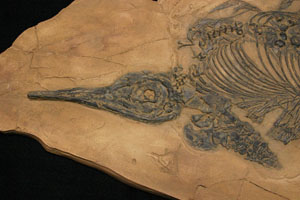The first Ichthyosaurs were found in the early 1800's. It was quickly recognized that they were marine animals but were not fish or mammals, like today's dolphins or whales. Since their skeletal remains were closely related to reptiles, they were given the name Ichthyosaurs (which means fish lizard). From the time of their initial discovery until now, more than 80 species of Ichthyosaurs have been recorded.
The earliest Ichthyosaurs (250 million years ago) displayed many similarities between themselves and lizards, and because of these similarities lizards are their most likely ancestors. These early Ichthyosaurs still had neck, thick bodies, and long tails. No dorsal fin had yet developed and it is thought that they swam by undulating their bodies from side to side in much the same fashion as today's iguanas and crocodiles. Of the five families in the order Ichthyosauria, these "eel-like" Ichthyosaurs are found in the family called Shastasauridae.
The next family are the Mixosauridae. These reptiles seem to bridge the gap between the reptile-like Shastasauridae Ichthyosaurs and the "true," dophin-like Ichthyosaurs. The Mixosaur typified these Ichthyosaurs with a streamlined body and a dorsal fin. It had only the beginnings of a fish-like tail or fluke.
A third family, the Ichthyosauridae, started to appear by the Jurassic. They had sleek bodies, long porpoise-like noses, dorsal fins, and a fish-like tail fluke that typifies an Ichthyosaur. They would have swam by sweeping their tails from side to side while keeping their heads reltively still. This family includes the "type" member, Ichthyosaurus, as well as the Ophthalmosaurus (which is known as having the largest eyes of any creature that ever lived).
A second family, the Stenopteryiidae, also evolved during the Jurassic. They were similar to the ichthyosaurids with a few important differences. They had smaller heads, longer and narrower paddles (with only five toes - members of the Ichthyosauridae had up to nine toes).
The Leptopterygiidae was the final family to evolve. The Temnodontosaurs (also known as Leptopterygius) and the strange looking Eurhinosaurus (whose nose is similar to that of a modern sawfish) are members of this family.
Due to some remarkably well preserved specimens it has been determined that their skin color was a deep brown with a lighter color along their bellies. These well preserved fossils also indicate that they gave live birth to their young, with some individuals holding up to three "pups."
The fossil record shows that the Ichthyosaurs died out well before the KT Boundary, 65 million years ago. The reason for their extinction therefore remains a mystery.
Mixosaurus cornalianus 
Quantity in Basket: None
Code: REP-400
Price: $600.00
Time: Middle Triassic Period approximately 225 million years ago.
Location: Monte San Georgio Formation, Switzerland
Dimensions: 47" x 15-1/2" x 1"
Allow 4-6 week for delivery